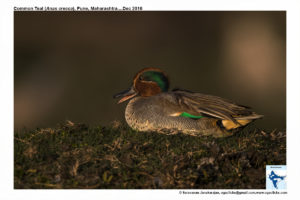Common Teal

Common Teal Anas crecca
Etymology:
- Anas : Latin word for Duck
- Crecca : Swedish name Kricka for the Common Teal
Vernacular Names: Sind: Kardo, Hindi: Chhoti murghabi, Kerra, Lohiya kerra, Chowtee, Patari, Souchuruka, Sans: Rohinik hansak, Pun: Til, Mirshikars: Baijla, Ben: Naroib, Patari hans, Tulsibigri, Ass: Kalimari, Chila hanh, Patari hanh, Mani: Surit, Cachar: Daophlantu kashiba, Nepal: Baijila gairi, Guj: Nani batak, Murghabi, Nani murghabi, Mar: Chakrang Badak, Ta: Siravi, Kilawai, Te: Parza, Mal: Yeranda, Kan: Solari hakki, Neeru baatu, Sinh: Seruwa
Distribution in India: Widespread winter visitor.
Description: Size of 34-38 cm. Male has a red-brown head with green stripe from eye to nape fringed buff, buff-cream breast spotted black, flanks and back vermiculated grey-white, belly and rest of underparts white, except black-bordered triangle of cream-yellow on under tail-coverts, mid-grey wing-coverts with buff-brown tips, underwing mostly white, bill dark grey, legs and feet blue-grey or olive-grey, and eyes warm brown; eclipse plumage resembles that of adult female but is darker and more uniform, with less distinct dark eye stripe. Adult female has grey-brown head and neck, with darker crown and stripe from bill base through eye, striated neck and cheeks, slightly darker back and rump, breast and belly almost white, brown wing-coverts with pale fringes and tips, long scapulars with square tips, speculum has more black to green than in male, bill dark olive-grey usually with orange-yellow base and speckled black, legs and feet as male, and eyes brown.
Habitat: It is found in Small freshwater lakes, pools, slow-flowing rivers and shallow marshes with abundant fringe vegetation.
Food Habits: It eats during winter months seeds of aquatic plants, grasses, sedge, grain, emergent and submerged macrophytes, in spring and summer many aquatic invertebrates. The young feed solely on invertebrates for first few day. Feeds by dabbling, head dipping, upending and exceptionally diving in shallow water and also filters mud. Predominantly feeds at night during non-breeding season, but by day when nesting.
Breeding Habits: They breed in March-May in North west and Central Europe The nest is deep hollow in ground, lined with dry leaves, grass and much down, built among dense vegetation, especially grass, but also in dwarf scrub and under bushes. It will accept artificial islands as nest-sites. Single-brooded, but will lay replacement clutch. Lays a clutch of 8–11 eggs. The incubation period is 21–23 days by female alone. The fledging period is 25–35 days.